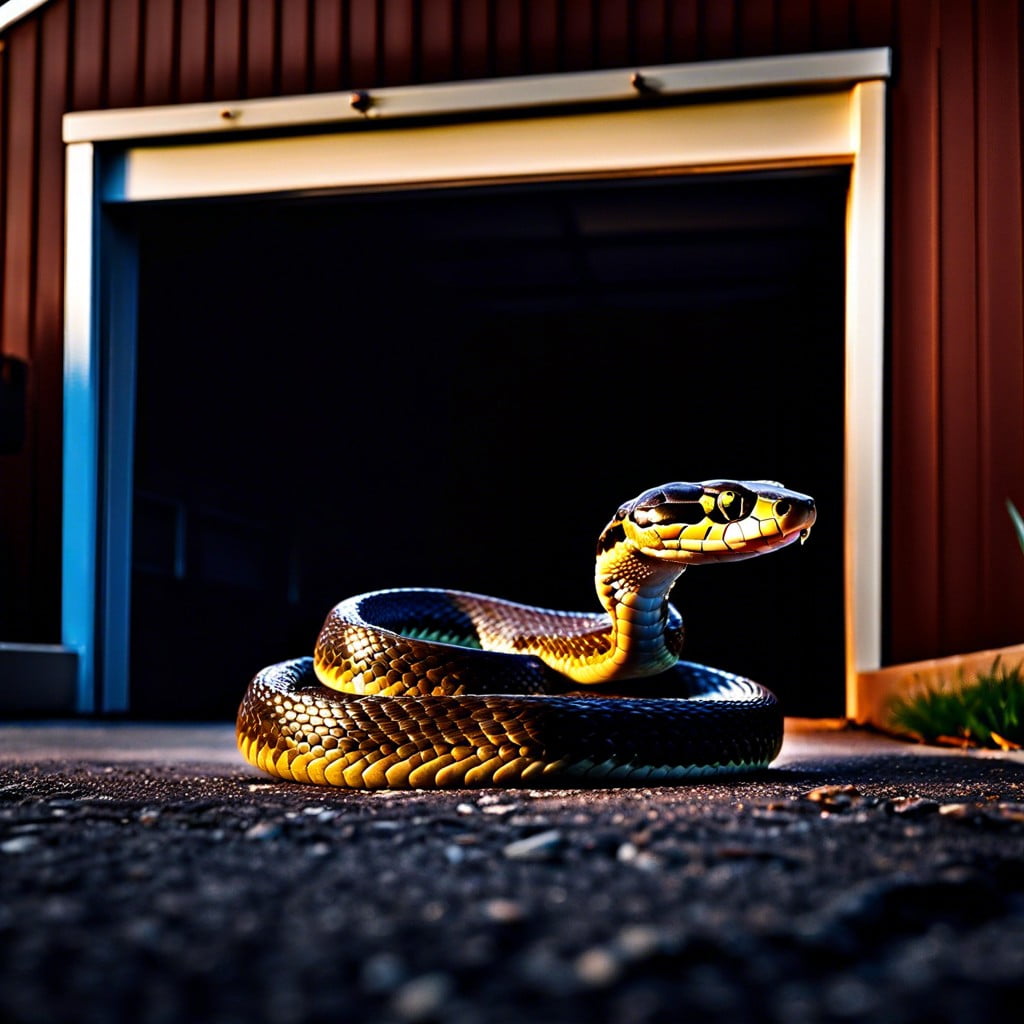Ever wondered what to do when you find a snake in your garage?
Key takeaways:
- Snakes seek garages for shelter, food, warmth, and hiding spots.
- They enter through gaps in doors, vents, pipes, cracked foundations, and windows.
- Signs of a snake include slithering sounds, shed skin, droppings, and hidden areas.
- Remove snakes by opening the garage door, using a broom, or calling professionals.
- Prevent future entry by sealing gaps, decluttering, installing weather stripping, trimming lawn, and storing food securely.
Why Do Snakes Get Into Garages?

Sometimes, your garage is just too inviting for a snake to resist!
First off, garages provide shelter. They offer a safe haven from predators and the elements. If there’s a dog or a hawk outside, the snake would rather cozy up near your toolbox.
Second, food! If you’ve got little critters like mice or insects, you’ve got a snake’s favorite buffet. It’s like opening a 24/7 diner and wondering why hungry customers keep showing up.
Garages can also be warm spots, especially in cooler months. Engine heat, warm corners, and sunny spots— these are the places a snake dreams about.
And let’s not forget the clutter factor. Piles of boxes, old furniture, and yard tools provide endless hiding spots. For a snake, it’s akin to a game of hide-and-seek where it never wants to be found.
Finally, easy access. Small gaps and openings provide the perfect entry points for these slithering guests. For them, it’s practically a red carpet welcome.
How Do Snakes Get Into Garages?
Snakes are pretty crafty when it comes to finding their way into garages. They don’t need grand doorways, just a teeny gap will do.
First, check the weather stripping on your garage door. Those little slithers can squeeze through small openings like seasoned contortionists. Missing, damaged, or just plain old weather stripping is an open invitation.
Vents and gaps around pipes are another sneaky entrance. Snakes adore these ready-made highways. A vent screen or sealant will keep those scaly guests out.
Cracked foundations can also serve as an entryway. Tiny fissures might seem harmless but to a snake, it’s like finding a secret trapdoor.
Lastly, keep an eye on your windows. If they’re not sealed properly, you’ve got a five-star entrance in the snake world. A simple caulking job can solve this.
Always remember, even the smallest crack can be an open door for a snake. Fix those gaps, and you’ll be blocking their path like an expert bouncer at a VIP club.
How to Tell If a Snake Is in Your Garage?
First, keep an ear out for any unexpected sounds. Slithering noises, or the faint hiss, might clue you in that a reptilian visitor has made itself at home.
Next, look for physical evidence. Snakes shed their skin as they grow, so finding a snake skin in your garage is a glaring hint. Not exactly the decor you had in mind, right?
Check for droppings. Though not a glamorous task, snake droppings are typically dark with a chalky white tip. If you spot these, you’re on to something.
Finally, scan dark, hidden areas. Snakes love to hang out in undisturbed places like behind boxes or in cluttered corners. Time to dive into those less-visited nooks and crannies!
Remember, Sherlock, the goal is to gather clues subtly without stirring up too much excitement.
How to Get Snakes Out of Your Garage?
First, don’t panic. Most garage snakes are harmless and just looking for a cozy hideout. But let’s make them a little less comfortable, shall we?
Start by carefully opening the garage door to give Mr. or Ms. Snake an easy escape route. Use a broom – not to whack the poor thing, but to gently guide it towards the opening. Treat it like an uninvited guest, not a hostile invader!
If that doesn’t work, place a box or bucket over the snake. Slide a piece of cardboard underneath to trap it inside. Then, simply carry it outside and release it into the wild like a backyard superhero.
Professional snake handlers exist for a reason. If the snake looks dangerous or you’re just plain terrified, call in the experts. They’ll ensure both you and the slithery intruder remain unharmed.
Last, but definitely not least, give your garage a thorough clean. Snakes love cluttered spots and cozy nooks. Less clutter means fewer hideouts – a win-win for everyone.
Preventing Further Entry
First, seal all gaps and cracks in your garage’s walls, doors, and windows. Snakes aren’t Houdini, but they can squeeze through surprisingly small spaces.
Next, get rid of their hiding spots. Snakes love clutter, so keep your garage neat and tidy. Dispose of old boxes, piles of clothing, and randomly placed tools. Think of it as spring cleaning, but with a reptilian twist.
Install weather stripping on your doors and windows to keep those sneaky serpents out. It also helps with insulation, so you win on multiple fronts.
Consider keeping the lawn around the garage trimmed. Overgrown grass is practically a welcome mat for snakes, and the less inviting your yard is, the better.
Store food securely. If you have pet food or birdseed in the garage, make sure it’s stored in tight containers. You don’t want to attract rodents, which just brings snakes that much closer.
Lastly, think about using snake repellents. There are commercial ones available, or you can make natural ones using essential oils like cinnamon or clove. Smells good and keeps the slithery dudes away.